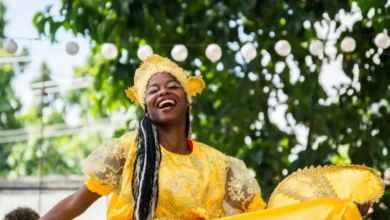Brazil, a vibrant nation brimming with passion and rhythm, has consistently influenced global culture, particularly in the realms of music and carnival celebrations. Its rich tapestry of indigenous traditions, African heritage, and European influences has created a unique cultural landscape that resonates far beyond its borders.
This article delves into the fascinating ways Brazilian culture has shaped international trends in music and Carnival, providing insight into the infectious energy and creativity that have captivated the world.
The Rhythmic Heartbeat: Brazilian Influence on Global Music
Brazilian music is more than just sound; it’s an expression of life, history, and emotion. From the soulful samba to the lively bossa nova, Brazilian genres have left an indelible mark on the global music scene. This section explores how these distinct sounds have captivated audiences and influenced artists worldwide.
Samba’s Global Sway
Samba, arguably Brazil’s most iconic musical form, is characterized by its syncopated rhythms, call-and-response vocals, and passionate delivery. Born in the early 20th century from the Afro-Brazilian communities of Rio de Janeiro, samba embodies the spirit of resilience and joy. Its influence can be seen in various genres globally.
See also How Caribbean Culture Influences Global Music and Festivals
How Caribbean Culture Influences Global Music and FestivalsLatin pop, for example, often incorporates samba’s infectious beats and percussive elements, creating a unique blend of sounds. Moreover, samba’s impact extends beyond just rhythm; it has also influenced dance styles and fashion trends worldwide.
The energy of Samba has inspired countless artists. International musicians, from rock to pop to jazz, have incorporated samba rhythms and instrumentation into their songs. This cross-genre collaboration has introduced samba to new audiences, leading to a deeper global appreciation for Brazilian music.
Bossa Nova: A Sophisticated Sound
In contrast to the energetic samba, bossa nova offers a more subtle and sophisticated sound. Developed in the late 1950s, it blended samba’s rhythmic base with elements of jazz harmony and cool melodic lines. The emergence of Bossa Nova, particularly with the release of ‘The Girl from Ipanema’, catapulted Brazilian music into the international spotlight. Its smooth vocals, gentle guitars, and intricate arrangements became synonymous with cool sophistication.
Bossa Nova had a huge impact on jazz, influencing generations of musicians and contributing to a distinct flavor of jazz music. Its relaxed yet engaging sound has found its way into cafes, lounges, and even commercial settings, establishing Bossa Nova as a timeless and globally enjoyed genre. The popularity of Bossa Nova is a testament to how a very localized and particular musical style can be widely embraced.
See also How Chinese Culture Shapes Traditions Across Asia and Beyond
How Chinese Culture Shapes Traditions Across Asia and BeyondOther Brazilian Musical Genres Contributing to Global Sounds
Beyond Samba and Bossa Nova, many other Brazilian musical styles have contributed to the rich tapestry of global sounds. For example, Forró, with its upbeat accordion and infectious rhythms, has found fans across Latin America and is increasingly being embraced in Europe and North America. MPB (Música Popular Brasileira) which is a diverse genre, blends elements of samba, bossa nova, rock and other influences, demonstrates Brazil’s ability to innovate while still retaining its core essence. The influence of these diverse styles is further solidifying Brazil’s musical impact on the world stage.
Carnival’s Global Spectacle: More than Just a Party
Brazilian Carnival is a legendary celebration known for its dazzling parades, elaborate costumes, and infectious energy. It’s more than just a party; it’s a powerful expression of cultural identity and artistic creativity. This section explores how Carnival has influenced celebrations and events around the world.
The Rio Carnival: A Global Inspiration
The Carnival in Rio de Janeiro is the most famous of the Brazilian Carnival celebrations and a major source of inspiration for festivals around the globe. It is a spectacle characterized by its samba school parades, in which thousands of participants wearing elaborate costumes perform meticulously choreographed routines while riding on spectacular floats. The Rio Carnival has influenced the aesthetic and organizational aspects of countless festivals worldwide.
The parades in particular have served as a template for large-scale events globally. The emphasis on visual spectacle, rhythmic music, and community participation has become a model for many parades and festivals, with organizers seeking to recreate the dazzling energy of the Rio Carnival. This includes the incorporation of elaborate costumes, floats and coordinated group performances.
Carnival’s Influence on Global Festive Traditions
Carnival’s influence transcends mere imitation. The themes of community, celebration, and artistic expression have resonated with diverse cultures, leading to the incorporation of Carnival elements into existing festive traditions. Cities around the globe have adopted elements from Carnival, incorporating it in their local traditions. This cross-cultural exchange highlights the universality of the human desire to celebrate and express through music, dance, and spectacle. The global adoption of Carnival principles is further evidence of Brazil’s significant cultural influence.
Beyond Parades: Carnival as a Cultural Phenomenon
Carnival’s influence extends beyond parades and festivals. The vibrant colors, unique designs, and overall creative spirit of Brazilian Carnival have permeated fashion, art, and design. The costumes, often extravagant and flamboyant, have inspired designers and artists worldwide. The emphasis on elaborate detail and the blending of traditional elements with modern aesthetics make Brazilian Carnival a constant source of creative inspiration.
Furthermore, the communal aspect of Carnival is often emphasized in global events. The idea that festivals should be a time for collective joy and participation has been increasingly adopted by various cultural celebrations, as a nod to the shared spirit of the Brazilian Carnival. The focus on participation, community and the display of cultural pride is what makes Carnival such a unique and influential phenomenon.
The Fusion of Cultures: The Foundation of Brazilian Influence
The strong global influence of Brazilian culture is rooted in its unique fusion of diverse cultural elements. This blend of indigenous, African, and European traditions has resulted in a vibrant and multifaceted culture that continues to inspire the world.
African Rhythms and Traditions
The impact of African culture is perhaps the most pronounced in Brazilian music and Carnival. The rhythmic complexity of Samba, for example, directly originates from African drumming traditions. The use of percussion instruments and the emphasis on syncopation are direct legacies of the transatlantic slave trade. Furthermore, the call-and-response singing patterns often seen in Brazilian music can also be traced back to African musical practices.
In Carnival, the influence of African culture is equally pervasive. The emphasis on communal participation, the use of vibrant colors, and the spiritual aspect of the celebrations all reflect African traditions. It highlights the remarkable way in which marginalized communities have been able to preserve and celebrate their culture through music and dance. The blend of cultures in Brazil is what gives it its unique character and widespread global appeal.
Indigenous Roots and Cultural Heritage
While African and European influences are prominent, Brazilian culture also has deep roots in its indigenous heritage. The indigenous cultures of Brazil have contributed to the country’s diverse artistic expressions. Many traditional crafts and art forms reflect the rich history and artistic abilities of Brazil’s original inhabitants, with the use of natural materials in art and crafts often inspired by indigenous techniques. The resilience and cultural richness of indigenous traditions have significantly contributed to Brazil’s unique character.
European Influences and Adaptations
European colonization left an indelible mark on Brazilian culture, particularly in architecture, language, and some musical forms. European instruments like the guitar and accordion are integral parts of several Brazilian music genres. European traditions and festivities were also adapted and reshaped, merging with other traditions to give a unique Brazilian twist. The blend of European, indigenous and African influences makes the nation’s cultural landscape so appealing to a global audience.
Conclusion: A Lasting Global Impact
Brazilian culture, with its infectious rhythms and vibrant celebrations, has undeniably left a significant mark on global trends in music and Carnival. From the soulful sounds of samba to the dazzling spectacle of the Rio Carnival, Brazil has consistently captivated the world with its unique blend of tradition and creativity.
The fusion of African, indigenous, and European influences has created a cultural landscape that resonates with diverse audiences across the globe. As we continue to celebrate the cross-cultural exchange of ideas and traditions, the influence of Brazilian culture will undoubtedly continue to inspire and enrich the world.
The enduring popularity of Brazilian music and the global embrace of Carnival elements serve as a testament to the power of culture to transcend borders and unite people through shared experiences of joy, creativity, and artistic expression. Brazilian culture is not only a source of entertainment, but also a powerful example of how a unique blend of traditions can create a cultural phenomenon with a global reach. It serves as a source of joy, innovation, and cultural understanding.“`




